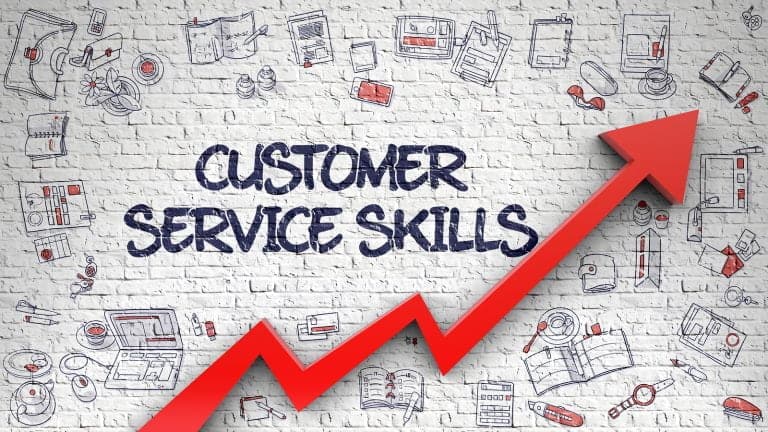Customer service is defined as ‘the assistance and advice provided by a company to those people (customers) who buy or use its products or services.’
Table of Contents
ToggleThe time span includes the provision of service to customers before, during, and after this purchase or use.
This definition makes it clear that a purchase isn’t necessary for a customer to expect to receive good service.
A great part of how customers perceive you and your organization is dependent on how good your service is.
The customer is the party who will gauge whether they are getting good service or not.
You might believe that you are providing great service, but if your customer has a different view of the service that they receive, then they might decide to go elsewhere.
This also includes product support that you offer to your customers, but the scope of customer service has to go further than that.
Focussing your approach just on providing support for when products or services fail will not give your customers the service that they expect to receive.

What Does Customer Service Mean to You?
If you are a customer, then you want and expect to have an easy and enjoyable experience right from the outset.
This starts when the customer is looking for something. If they can’t easily find what they are looking for, then they will probably go elsewhere to an organization that has considered how the customer experience is crucial to getting new customers right from the start.
A customer receiving the service wants to feel like an organization cares about them as an individual, in every interaction that they make.
That includes inquiries, making a purchase, looking for help and support, and making complaints about poor customer service.
Keeping Your Customer Happy
If you’re the organization providing the services and products, offering great service is important if you want to get new customers, retain existing customers, and grow your business.
Keeping your customer happy means going above and beyond providing just products and services.
Whether that means answering any questions that the customer has, or resolving issues that they experience with a helpful support agent.
In today’s digital world, your customer might never interact directly with any of your staff, so your approach has to include every interaction that the customer has with you, no matter what method they use.
It is now so easy for customers to get products from another supplier with just a mouse click, so maintaining customer satisfaction has to be the top priority, hopefully creating loyal customers who will not only buy more from you but also recommend you to their colleagues and friends.
Every Customer Is Unique
Every customer is different, so you need to consider many ways to provide service so that you can achieve your goals.
Customer expectations for what is good service change and grow over time.
What they think is great service today might soon be perceived as poor service tomorrow, as the customer experiences better service from another organization, or as they simply get used to your norm and demand a better experience.
This means that you need a service strategy and approach that has multiple channels of interaction and which is continually evolving and improving in line with technology and new approaches to service.
Different customers have different needs, desires, and expectations from customer service. Some customers want to use direct contact with humans.
Others might be reluctant to use this type of interaction for a variety of reasons, including disabilities, anxieties, and language issues.
Some customers can solve issues themselves, and perceive poor levels of service if they can’t do self-service.
You have to consider this wide spread of customer desires, capabilities, and behaviors.

Types of Customer Service
Today’s service operation goes far beyond the traditional provision of telephone support using agents.
Driven by technology changes, today’s customers expect to be able to interact using a variety of channels.
These include getting services by email, webpages, text messages, and a variety of social media channels.
Many companies also include self-service support, so customers can find their own answers at any time, day or night.
Customer service is much more though than just providing answers; it’s an important part of the promise that your brand makes to its customers.
Choices For Support Services
You need to use different channels because all of your customers are different.
They are individuals who will vary in their experience, expertise, and expectations of service.
What can be perceived as great service by one person might be perceived as bad service by another.
Hence you must discover and analyze your existing and potential customers’ preferred channels for interaction and what they are likely to perceive as good customer service.
Elements of Customer Service
Expectations of what is good service can vary significantly by generation.
Young ‘Millenials’ are far more likely to want to use social media, whereas customers born before 1950 often tend to prefer using the telephone, and feel challenged if your service approach is restricted to just online and social media channels.
One thing is common for all types of service: All customers expect prompt service, irrespective of which channel they use.
So, for each type, you need to consider which approach you take and will do the job most efficiently and effectively.
Here are some common types of ways for customers to access customer service:
Telephone
For many years this was the most common way to access customer service. This is still the most popular choice among all types worldwide.
In terms of popularity, email is still one of the top choices for accessing service. Nowadays, it is prevalent for companies to have an online contact form on their website that generates an email directly to customer service.
On-Site Support
This is delivered directly to the customers’ homes or workplaces. On-site customer service includes health, appliance repairs, teaching, and consulting.
Live Chat
In today’s digital world, this is an essential service tool for many businesses. An online chat tool is used by a customer to communicate directly with a service representative.
One key strength of a live chat is the ability to use chatbots, giving the capability to deal with frequently asked questions without any involvement by a live service representative.
Using live has a satisfaction rate of over 92% among customers.
Social Media
This is where communication and support are provided through social media channels, such as Facebook and Twitter.
As well as interacting with individual customers, this can also be used for group communications and discussions.
FAQ
The FAQ (Frequently Asked Questions) is a list of questions and answers relating to a particular topic.
FAQ questions can be grouped into categories or listed in any order and can be accessed by customers to provide self-service support.
Customer Self-Service
Some customers prefer to try to solve their problems on their own before they resort to contacting customer service.
Many companies offer a wide range of self-service materials such as webinars, instructional videos, tutorials, help-files, documentation, and online tools.
Providing a range of self-service materials, as well as a range of other channels, can greatly enhance the perception of the organization’s products and services, and ensure that the needs of all customer types are met.
Customer Support vs Customer Service
Customer service is not the same thing as customer support. Customer support only comes into use when an existing customer has an issue with the products or service provided, whereas customer service includes every interaction with a customer, irrespective of if they are an existing customer or not.
Good customer service encompasses handling inquiries about potential services, including providing helpful and understandable information to internet search engines.
Put Yourself in the Role of the Customer
The primary goal of customer support is to resolve the customer’s issue as soon as possible.
Whilst this is a good goal, it can sometimes ignore the wider needs of the customer.
Customer service considers every interaction with the customer in terms of satisfying that customers holistic requirements.
Most customers want to feel that the organization cares about them as an individual, and not just as a paying customer.
This requirement for service requires tailoring of how customer support is provided for different types of customer.
One good way to do this is for the support representatives to consider the interactions from the perspective of these customers.

All Customers Are Unique
Customer support is, of course, a fundamental aspect of customer service.
If the level of support does not match the expectations of the customer, then the customer will consider that they have had a poor experience, even if their issue has been resolved.
With today’s digital services, customer experience and customer service have become a fundamental part of the product or service itself.
Customer support can be accessed using features within the product, such as a Report Issues button.
Whilst these can provide a seamless way for customers to get help, customer experience will suffer unless they are easy to locate and use.
Some online businesses integrate access to their customer support centers into their website’s headers and footers, or by adding links to relevant support articles to specific pages on their site.
This can be an excellent way to improve customer service with customer support.

Create Premium Customer Services
Some customers are willing to pay more for a better experience. Focusing on the customer experience isn’t just the latest trend in business, it is also a smart way to operate.
Good service can increase your profits, as the costs of doing that can be lower than the price premium on your products and services.
Surveys show that over 80% of customers will pay more for excellent customer service. One useful approach is to categorize your products and customers.
Higher cost service categories for those customers that are prepared to pay more can include things like premium support, early access to new features, or other benefits.
For some products, especially commodities, offering a premium service for a higher price might not be cost-effective, as very few customers will pay extra.
Either way, positive customer experiences will benefit your bottom line.
Customer service is critical to competing effectively. Formerly customers mainly chose which companies they did business with based on price, or the product or service offered.
Today the overall service experience is often one of the primary selection criteria.
Importance of Customer Service
Great customer support can drive a positive customer experience, especially when your support teams move beyond just reacting to problems and toward anticipating customers’ issues.
When service representatives are empowered to go above-and-beyond, just customer support, they can create winning customer service experiences that help you stand out from your competitors.
It costs 6 or 7 times more to acquire a new customer than retain an existing one.
Bad customer service is usually the main reason that customers leave for elsewhere.
One survey showed that nearly 70% of customers leave because of a bad service experience.
Even if your products are good, a single bad service experience can lead to a lost customer.
And customers can have long memories. Even if you later improve how you provide customer services, surveys show that lost customers rarely return.
Prioritizing customer service helps you attract and retain loyal customers, and can have a significant impact on your company’s bottom line.

Areas of Customer Service Experience
There are several different areas of customer service. Each organization needs to decide which activities it needs to do to provide good customer service.
These will depend on the level of service that they want to provide and the nature of their business.
Typical customer service areas that are common to most businesses include the following:
- Listening and responding to customers’ needs and concerns
- Providing customer support for issues
- Handling returns or complaints about products and customer service
- Providing information about products and services
- Taking orders, determining charges, and overseeing billing or payments
- Reviewing or making changes to customer accounts
- Recording details of customer contacts and actions taken
- Developing and improving customer service FAQs
- Researching answers or solutions as needed
- Referring customers to supervisors, managers, or others who can help
- Quantifying the level of customer service provided, including surveys of customer service experience
- Continually reviewing and improving how customer service is delivered
Customer Service Examples
Here are some examples of how different organizations provide customer service:
Web Hosting Company
This global company provides web hosting to customers of all sizes worldwide.
Good customer service relies on the rapid provision of support to customers. This company primarily uses telephone support for customer service.
This is provided using toll-free numbers in each country where they provide services. Customer service is available 24 hours, 7 days a week, every day.
Global Courier Company
Shipment related issues could happen at any time of day or night, and the customers have different needs for service.
So, this company provides customer support using telephone and online chat.
These types of services facilitate immediate support and are provided in each country where the courier operates.
Email is primarily used where the query isn’t urgent.
Large Hotel in a Tourist Location
This is an example of a business operating in the accommodation sector.
To meet the needs of customers living in different time zones, the hotel offers the possibility to make a booking inquiry by sending an email.
This is an ideal type of customer service for dealing with questions coming from any time zone.





